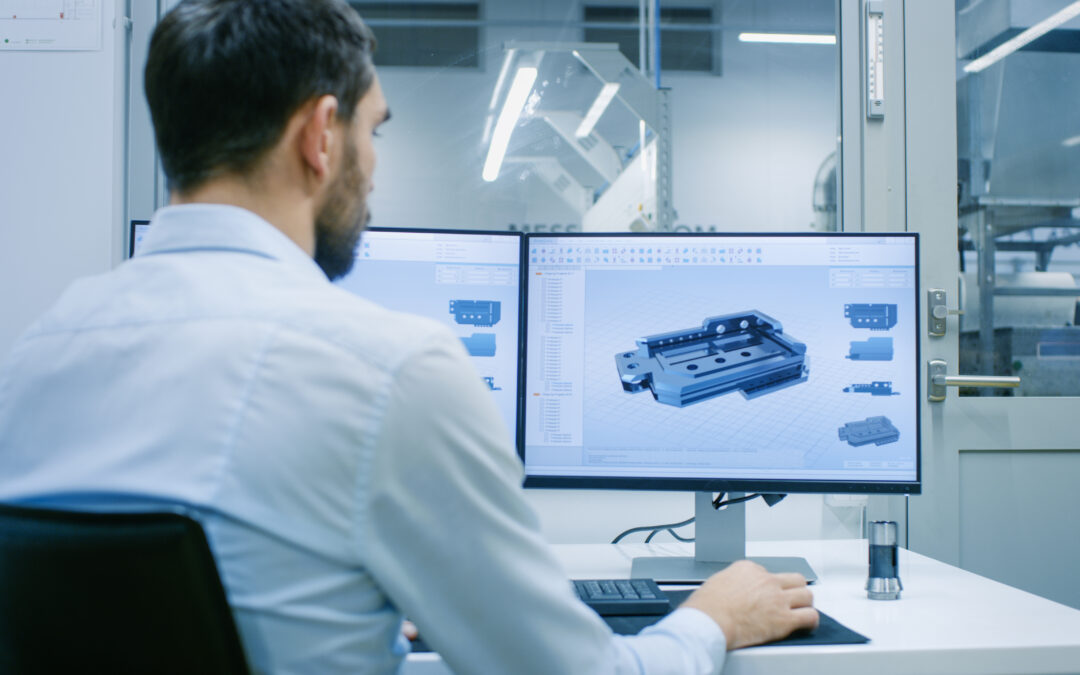Industry 4.0, or the “fourth industrial revolution,” also called Model Based Enterprise (MBE), refers to the trend of automation and data exchange in manufacturing which results in “smart” factories.It represents a new stage in the organization and control of the industrial value chain.
In the context of MBE, Model Based Definition (MBD) unifies design, manufacturing, quality, and other disciplines. MBD digitally transforms manufacturing and factories from traditional 2D drawing-based workflows to a 3D CAD model-based workflow, with geometry, manufacturing data, and other data all contained in one digital file.
Ultra Precision uses Model Based Definition in a large percentage of their manufacturing production programs, such as CNC programming. Ultra Precision also uses MBD in inspection and quality testing, using a coordinate measuring machine (CMM) to compare the modeling to physical parts.
What is Model Based Definition?
Model Based Definition, according to Capvidia, is the process of using a 3D CAD model that establishes and incorporates product manufacturing information as the definitive authority throughout the product lifecycle. It is a method of unification resulting in a “single source of truth” to be referenced throughout the manufacturing process.
The MBD 3D CAD model includes all manufacturing data in its single file. It is readable and interpretable by both humans and machines. This includes information such as: Geometric dimensioning and tolerancing (GD&T); bill of materials (BOM); surface finish; weld symbols; manufacturing or measurement process plan data; metadata and notes; history of engineering change orders; legal, proprietary, export control notices; and any other definitive digital data.
This model-based engineering approach is the new form of handling manufacturing data which uses models instead of traditional documents for all manufacturing practices. . Perhaps most importantly, MBD data is interoperable and CAD/CAM/CAE agnostic. As such, it is the basis of Model Based Manufacturing and Model Based Enterprise.
Why is MBD Important?
As industry moves toward Model Based Manufacturing, the MBD process becomes increasingly important. Model Based Definition provides engineers across the enterprise and throughout the product lifecycle a consistent and commonly-shared basis upon which to model, measure, test, and refine. This collaborative setting and foundational context facilitate more rapid and meaningful feedback loops, better decisions, and faster-to-market products.
MBD enables the easy and consistent sharing of technical information throughout an enterprise which is perhaps just as important as the nature of the technical information itself. It is critical in a product’s lifecycle. Model Based Definition contributes to ensuring production efforts are not hindered, inspection processes are properly and thoroughly completed, and assembly methods result in proper-fitting parts.
In short, while reducing cost through automation and time-saving, MBD is important because it increases the speed, accuracy, and efficiency of the manufacturing process.
Bridging the Gap: Benefits of MBD on Modern Manufacturing
According to the American Society of Mechanical Engineers (ASME), the state of manufacturing today is moving towards Model Based Manufacturing and Model Based Enterprise, leveraging digital data across the entire operation. Advanced techniques for better product representation and lifecycle management are in demand as digital data is increasingly used in product and process roadmaps. MBD bridges the gap between traditional processes prone to human error, and the digital revolution.
Manual transcription and interpretation can lead to confusion between various departments and among poorly documented revisions and versions. In turn, these lead to more time spent on the manufacturing process, increased risk of error, and overall higher cost.
MBD catches errors earlier in the product lifecycle, reducing manufacturing scrap and the need for rework and recalls. Errors due to design changes that have not been notated or simply poor or inconsistent design implementation and manufacturing are greatly reduced. Significant cost savings result from MBD-driven corrections made in the design phase rather than the testing phase.
Ultra Precision and Model Based Definition
MBD increases the speed, accuracy, and efficiency of the manufacturing process while reducing costs through automation and time-saving.
By implementing technologies and methods that are quickly becoming industry standards into production and inspection processes, Ultra Precision enables customers to fully benefit from the MBD process. Using 3D models allows Ultra Precision to better interpret complex, high-feature-count parts. They also better position Ultra Precision process engineers to fully understand the part versus interpreting it from 2D drawings.
While implementation may require additional digitization on the floor with technology throughout the shop, in the long term, customers realize all of the benefits of Model Based Definition: Higher accuracy in production and quoting; time savings; cost savings; and less scrap. MBD also allows for fewer errors, and when they do occur, they are typically found early in the quoting stage as opposed to midstream production.
Ultra Precision’s MBD process facilitates customer communication and collaboration throughout the manufacturing process. It leads to precise parts, cost savings and stronger customer relationships.
Contact Ultra Precision today for a quote.
 Made in the USA
Made in the USA
